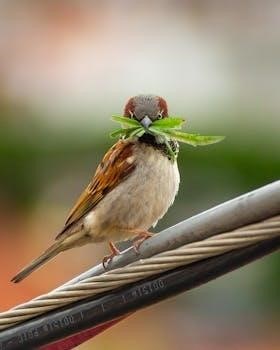Bird nests are diverse‚ reflecting varied species needs․ These structures serve as cradles for eggs and chicks․ They can be made from a variety of natural or man-made materials․ Nest designs depend on the species and environment․ Understanding nest types reveals avian adaptation and ingenuity․
Overview of Bird Nest Diversity
The world of bird nests is incredibly diverse‚ with each species exhibiting unique architectural skills․ Nests vary significantly in shape‚ size‚ and the materials used in construction․ Some birds meticulously build cup-shaped nests‚ while others create platform nests or even burrow into the ground․ The diversity reflects the specific needs of each bird species‚ taking into account factors such as predator avoidance‚ climate‚ and available resources․ Bird nests are not just simple structures; they are complex creations that showcase the remarkable adaptability of birds․ Some nests are crafted from mud and clay‚ while others utilize twigs‚ grass‚ leaves‚ feathers‚ and even spider silk․ The materials used often reflect what is readily available in their environment․ This variability highlights the resourcefulness and ingenuity of these feathered architects․ Furthermore‚ nest locations are just as diverse‚ ranging from tree branches and cliff edges to hidden burrows and man-made structures․ This broad spectrum of nest types and locations shows the incredible range of avian adaptation and the fascinating interplay between birds and their environment․ The study of bird nests offers a captivating glimpse into the natural world․
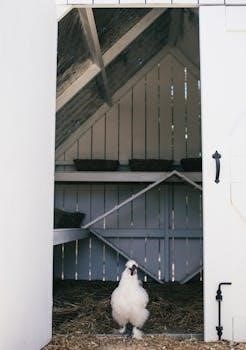
Types of Bird Nests
Bird nests come in various forms‚ each suited to different species․ Common types include mud nests‚ cup-shaped nests‚ platform nests‚ and burrow nests․ Hanging nests also demonstrate unique construction techniques․ Each type offers specific advantages for protecting eggs and young․
Mud and clay nests are architectural marvels constructed by certain bird species‚ showcasing their remarkable building skills․ These nests‚ often resembling miniature adobe structures‚ are meticulously crafted using mud‚ clay‚ and sometimes other binding materials like plant fibers or saliva․ Birds typically gather wet mud or clay from puddles‚ streams‚ or damp soil and carry it to their nesting site․ The mud is then shaped and molded into a cup-like or bowl-like structure․ They create layers of mud‚ allowing each to dry‚ gradually strengthening the nest’s walls․ Barn swallows‚ cliff swallows‚ phoebes‚ and robins are some birds that are known to create nests using mud․ These nests are often found attached to vertical surfaces such as cliffs‚ walls‚ or under eaves․ The mud acts as a durable building material‚ providing protection from weather and potential predators․ The weight of the mud also ensures stability for the nest and the eggs or chicks inside․ Mud nests can be incredibly resilient‚ sometimes lasting for many seasons and reused by the same bird or their descendants․
Cup-Shaped Nests
Cup-shaped nests are among the most common types of bird nests‚ showcasing a classic design that has proven effective for many species․ These nests are typically characterized by their bowl-like or cup-like structure‚ providing a secure and comfortable space for eggs and chicks․ They are often constructed using a variety of materials‚ including twigs‚ grasses‚ leaves‚ plant fibers‚ and sometimes even mud․ These materials are woven‚ intertwined‚ and bound together to create a sturdy and supportive cup․ The inner lining is usually made of softer materials like feathers‚ down‚ or plant fluff to provide insulation and cushioning for the young․ Many songbirds‚ such as robins‚ sparrows‚ and finches‚ build cup-shaped nests․ The size of the nest varies depending on the bird species‚ ranging from small‚ delicate structures to larger‚ more robust ones․ Cup-shaped nests are often placed in the forks of tree branches‚ shrubs‚ or other sheltered locations‚ offering protection from predators and harsh weather conditions․ The design’s simplicity and adaptability make it a popular choice among birds․
Platform Nests
Platform nests are broad‚ flat structures often built by larger birds․ These nests‚ unlike cup-shaped ones‚ do not have deep sides․ They are typically made from a collection of sticks‚ twigs‚ and other substantial materials․ The construction process often involves piling these materials to create a level surface․ Eagles‚ hawks‚ and herons are known for building platform nests․ The size of these nests can vary significantly‚ with some growing to be quite large and heavy over time as they are reused and added to․ Platform nests are frequently located in high places‚ such as tall trees‚ cliffs‚ or even man-made structures like utility poles․ The height provides a vantage point and protection from ground-based predators․ These structures are often substantial enough to support multiple eggs and chicks at once․ Birds may also use soft materials like grasses and leaves to create a more comfortable lining on the platform․ The open nature of platform nests allows for good air circulation‚ important in warmer climates․
Burrowing Nests
Burrowing nests are unique in that they are constructed in the ground or within existing cavities․ These nests offer significant protection for eggs and young from the elements and predators․ Birds that create burrowing nests often dig tunnels in soft soil or sand‚ creating a chamber at the end․ The tunnels can vary in length and complexity‚ depending on the species․ Puffins‚ kingfishers‚ and some species of owls are well-known for making burrowing nests․ Some birds may utilize existing burrows made by other animals‚ modifying them to suit their needs․ The interior chamber of a burrowing nest is often lined with soft materials‚ such as grasses‚ feathers‚ or plant fibers‚ to create a comfortable space․ The enclosed nature of the burrow helps maintain a stable temperature and humidity‚ crucial for incubation and chick development․ The entrance to the burrow can be hidden or camouflaged to deter predators․ This type of nest provides an excellent secure environment‚ safeguarding the eggs and young from many external threats․
Hanging Nests
Hanging nests are masterpieces of avian architecture‚ suspended from branches or other structures․ These nests are often intricately woven and provide a secure‚ swaying cradle for eggs and chicks․ The materials used for hanging nests vary widely‚ including plant fibers‚ grasses‚ spider silk‚ and even animal hair․ Weaverbirds‚ orioles‚ and some vireos are known for their elaborate hanging nests․ The nests’ construction typically involves a complex process of weaving and knotting‚ resulting in a strong‚ flexible structure that can withstand wind and rain․ The entrance to a hanging nest is often a small opening‚ sometimes located at the bottom or side‚ offering further protection from predators․ The hanging nature of these nests provides a natural defense‚ as many predators find it difficult to access them․ Some hanging nests are very compact‚ while others are pouch-like‚ offering a cozy and safe environment․ The flexibility of the hanging nest allows it to sway with the wind‚ which helps to keep it from being damaged by stronger gusts․
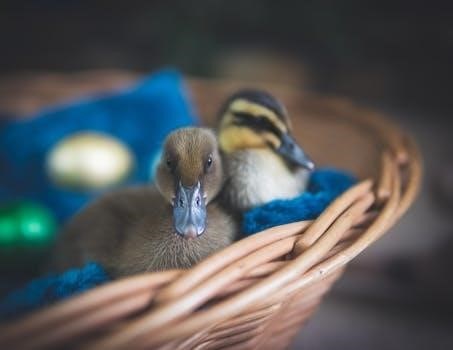
Bird Nesting Materials
Birds utilize diverse materials for nest construction․ Natural items like twigs‚ grass‚ and leaves are common․ They also use feathers‚ plant fibers‚ and spider silk․ Some incorporate mud or human-made items․ Material choice affects nest structure and insulation‚ impacting chick survival․
Natural Materials⁚ Twigs‚ Grass‚ Leaves
Twigs‚ grass‚ and leaves form the cornerstone of many bird nests‚ offering a blend of structural support and insulation․ Birds meticulously gather these materials‚ selecting twigs of varying sizes and strengths to create a sturdy framework․ Grass‚ both dry and green‚ is woven into the structure‚ adding bulk and cushioning․ Leaves‚ often dry and brittle‚ contribute to the nest’s overall insulation and camouflage․ The specific combination and arrangement of these materials vary widely among species‚ reflecting their unique nesting needs and preferences․ These natural components are readily available in most habitats‚ making them a convenient choice for birds․ Birds often utilize fallen leaves and unraked twigs from the yard‚ which provide excellent materials․ The resourceful use of these materials highlights the adaptability of birds in utilizing their natural surroundings․ These materials provide the basic building blocks for a safe and comfortable nest for the birds and their young․ Birds often will use plant cuttings‚ dried grass and natural fibers in their construction․
Feathers and Down
Feathers and down play a crucial role in nest construction‚ primarily for insulation and cushioning․ Birds often incorporate their own shed feathers or those gathered from other birds into the nest lining․ This creates a soft‚ warm environment‚ essential for incubating eggs and protecting vulnerable hatchlings․ The fluffy texture of down provides excellent thermal insulation‚ helping to maintain a stable temperature inside the nest․ In addition to insulation‚ feathers can also add to the structural integrity of the nest․ Smaller feathers are sometimes interwoven with other materials‚ strengthening the nest walls․ The use of feathers and down underscores the natural resourcefulness of birds in using available materials to create comfortable and protective homes for their young․ These materials are like nature’s own silk threads‚ soft and delicate‚ yet incredibly strong․ The presence of feathers in a nest is a testament to a bird’s skill in creating a safe‚ comfortable‚ and nurturing environment․ Birds choose to use feathers because of the benefit of thermal properties․
Plant Fibers
Plant fibers are a fundamental component in many bird nests‚ offering versatility in construction․ Birds utilize a wide array of plant materials‚ from fine grasses and dried leaves to strips of bark and fluffy seed heads․ These fibers provide both structural support and insulation for the nest․ Different plant fibers offer varying degrees of strength and flexibility‚ allowing birds to create nests of different shapes and sizes․ Some birds weave plant fibers together to form a sturdy cup shape‚ while others use them to create a soft lining․ The selection of plant fibers often depends on the availability in the bird’s environment and the specific requirements of the nest․ Birds may gather dried grass‚ leaves‚ and plant fluff․ They also utilize bark strips and plant down․ These materials are often intertwined with other materials․ Plant fibers can often be found by placing plant cuttings and dried grass in a garden․
Spider Silk
Spider silk is a remarkable material utilized by some bird species in nest construction․ This natural fiber provides exceptional strength and elasticity‚ making it ideal for binding nest components together․ Hummingbirds are particularly known for their use of spider silk‚ incorporating it into their tiny‚ delicate nests․ The silk allows the nest to stretch and expand as the chicks grow‚ preventing it from falling apart․ Furthermore‚ spider silk is lightweight and flexible‚ which is particularly advantageous when building a nest that is attached to a tree branch․ It also provides camouflage by helping attach the nest to its surroundings․ The silk’s adhesive properties help secure other materials like down‚ moss‚ and plant fibers․ By incorporating spider silk‚ birds can create nests that are not only strong and durable but also incredibly adaptable and comfortable for their young․ This ingenious use of spider silk shows the creativity of birds when building nests․
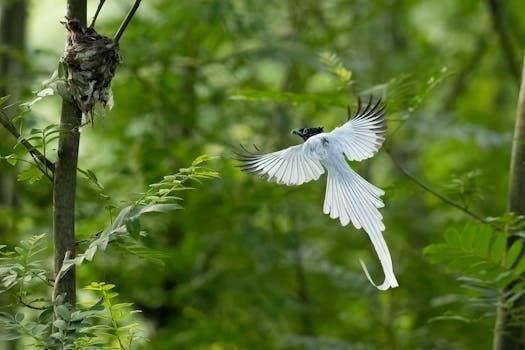
Mud and Clay Nests
Mud and clay are essential building materials for certain bird species‚ resulting in durable‚ sturdy nests․ These nests are meticulously crafted‚ often with layers of mud or clay applied to a framework of twigs or other materials․ The mud acts as a binding agent‚ holding the structure together as it dries․ Barn swallows and phoebes are well-known for constructing mud nests‚ which are commonly attached to vertical surfaces like cliffs‚ walls‚ or under eaves․ The process involves the birds gathering mud or clay‚ mixing it with saliva‚ and shaping it into small pellets that are then attached to the nest structure․ This creates a solid‚ cup-shaped nest that provides good insulation and protection from the elements․ The mud also provides structural support․ The resulting nests are often very robust and can last for many years with some maintenance․ These nests are a testament to avian architectural skills․
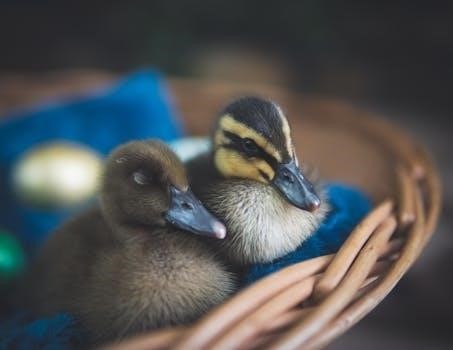
Man-made Materials
Birds are incredibly adaptable and often incorporate man-made materials into their nests when natural resources are scarce or not readily available․ These materials can range from bits of plastic‚ string‚ and yarn to discarded fabrics‚ paper‚ and even metal․ Dryer lint‚ though seemingly convenient‚ can pose dangers to birds and should be avoided․ While birds may use these materials for insulation or structural purposes‚ it’s important to recognize the potential risks․ For instance‚ plastic can be harmful if ingested or if it entangles young birds․ Similarly‚ some fabrics might not provide adequate drainage and can trap moisture․ Bird enthusiasts can help by providing natural‚ bird-friendly materials rather than items that could harm birds․ While these man-made additions are a testament to avian resourcefulness‚ it is important that humans ensure that we do not inadvertently harm them with our garbage․ The adaptability of birds to utilize these materials is fascinating‚ yet it also highlights the impact of human activities on the environment․
